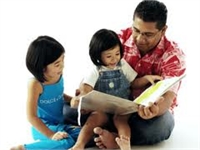
Developing Early Reading Skills
Important Notice: Our web hosting provider recently started charging us for additional visits, which was unexpected. In response, we're seeking donations. Depending on the situation, we may explore different monetization options for our Community and Expert Contributors. It's crucial to provide more returns for their expertise and offer more Expert Validated Answers or AI Validated Answers. Learn more about our hosting issue here.

Developing Early Reading Skills
You must be logged in to post a comment.
Even though technology may be slowly changing from books to e-readers and computers, children must still learn how to read to succeed. The first five years of your child’s life is the most essential time for learning language skills. There are many things you should know as a parent and activities you can do with your child to ensure that they learn to enjoy reading as a wonderful experience.
Perhaps the most important activity you can do with your child is to read with them consistently. Rosemary Wells, author of Read to your Bunny, put it perfectly – "Reading together twenty minutes a day is the most important gift you can give your child." When you first begin to read to your child as an infant, what you read matters less than the reading itself. If you are reading to an infant or a very young toddler, it is more the sound of your voice, the fact that you are spending time with them, and the routine of reading together that matters.
As your child begins to notice the words and pictures as you point them out, there are more activities you can add that will help your child develop the six pre-reading skills. Here are a few guidelines for reading with children:
– Keep books accessible to the children, perhaps on a low bookshelf.
– Make reading books together a bedtime routine.
– Don’t use the words. Use only the pictures and make up your own story!
– Act out the story together.
– Use silly voices for each different character in the story.
– Utilize your library story time. Help your child pick out more books to enjoy together while you are there.
During the first five years of life children develop early literacy skills. These prepare them to learn and succeed and generally fall into six categories, as mentioned above. Here are their definitions and an activity to go with each.
Narrative Skills– The ability to describe things and tell stories; Ask open ended questions about pictures such as: "What do you think is happening here?" to encourage children to make up their own stories.
Letter Knowledge– Understanding that each letter has its own name and sounds; Write words your child finds appealing such as "dinosaur" or "sparkle" using magnetic letters and a crayon or pencil and paper.
Phonological Awareness– The ability to recognize and play with the smaller sounds that make up words; Play with rhymes. Read simple poems and have children guess the last word in the rhyme. Play with words by taking them apart and putting them back together with another letter. "What would we have if we took the "b" off of bat? or "What do we have if we take the pop off of popcorn?
Print motivation– Believing that reading and books are fun; Make sure your child sees you reading! Make reading a special time for just the two of you.
Print awareness– Recognizing print and understanding how books work; Read aloud to your child often, pointing to the words as you read. This forms a connection between what you are saying and what is on the written page. ; Hold the book upside down or backwards, will your child turn it the right way?(Raising Readers, n.d.)
Though there are many other things you can do on the road to raising a reader, this should give you a good start. Below are a couple of good websites to help you on your way.
http://www.rif.org/parents/tips/default.mspx#cat186
http://www2.scholastic.com/browse/collection.jsp?id=318